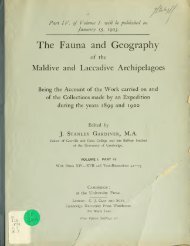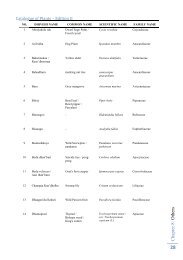:696 L. A. BORRADAILE.the whole, however, their general shape of body, with a bent abdomen carrying good pleura,subcylindrical or depressed cephalothorax, and fourth pair of legs like the third rather thanthe fifth, shows a nearer kinship to the Galatheidea than to any of the other groups, andin the absence of any evidence to the contrary this judgment must stand. As for theirlikeness to the Raninidae among the Crabs, an admission that this indicated relationship wouldlead to great difficulties, as for instance that the Raninidae must either be removed fromthe closely related Oxystomes or the latter be supposed to be derived by modification fromthe highly specialised Hippidea—in itself a very unlikely speculation.Each of the above groups has its peculiar habits and habitat. The Galatheidea hideunder stones or dwell in weed. The Thalassinidea generally make burrows, but the moreprimitive genera among them show a tendency to shelter in weed or sponges. The Paguridea(except Lithodinea) place their abdomen in the hollow of some foreign body, which is usuallya gastropod shell, but in the primitive genera may be a stone or a sponge. The Hippideabury themselves in the sand. Of these habits, that of the Galatheidea is the least specialisedand could easily have given rise to the others.We are now in a position to sum up in the form of a tree the results reached in thisand former articles (PI. XLVIII.). When this is done two facts of importance appear. Firstthat the proper place of the Thalassinidea is in the midst of the anomurous groups, andthat they must no longer be classed with the Macrura, and secondly that, when this changeis made, the Anomura, like the Brachyura, be<strong>com</strong>e a true, monophyletic group. Thus thereptant decapods fall into three divisions, Brachyura, Anomura' and Macrura. To the subjectof the taxonomic value of these groups and their relation to the natant families I hope toreturn later on. For the present they may be called suborders'-.The following keys give more precisely the classification of the groups discussed aboveKey to the reptant suborders of the Decapoda.I. 3rd pair of legs like the first, either chelate or simple and subcylindrical. Abdomen macrurous(straight, symmetrical, well armoured, with good pleura and strong, broad tail-fin, a lobe onthe first segment clipping the carapace). Gnathobase of 2nd maxilla narrow. Basipoditic lobeof 1st maxilliped usually deep. Exopodites of maxillipeds witli lash directed forwards. Gillsnumerous. [Last thoracic segment with legs not difl'ering greatly from the rest and sternumrarely free.] Macrura.II. 3rd pair of legs unlike the tirst^ never chelate. Abdomen rarely macrurous. Gnathobase of2nd maxilla typically broad. Basipoditic lobe of 1st maxilliped broad but shallow, its inneredge in a line with that of tlie coxopodite. Exopodites of maxillipeds with lash, when present,nearly always bent inwards. Gills usually few. Last thoracic segment with limbs often differinggreatly from the rest and sternum free or not.]. Carapace not fused with epistome. Last thoracic sternum free, its legs diflfering always clearlyin size and position and nearly always in shape from the third pair. Abdomen anomurous(reduced in some of its features but showing clear traces of some other function than thatof reproduction and almost always carrying biramous limbs on the 6th segment) or, rarely,1Unlike Boas' term " Anomala," the name " Anomura" which it has not had before,'^has had very different meanings in the pages of different The Brachyura is ranked lower on p. 427.writers. This fact allows it to be used here with a denotation ' See footnote to p. 693.
MARINE CRUSTACEANS. 697macrurous. A moveable autennal scale often present. Third pair of maxillipeds usuallynarrow. Anomura.2. Carapace fused with epistome at the sides and nearly always in the middle. Last thoracicsternum fused with the rest, its legs often like the others. Abdomen brachyurous (small,straight, symmetrical, bent under the thorax, showing no traces of any other function thanthat of reproduction, and without biramous limbs on the 6th segment). Never a moveableantennal scale. 3rd pair of maxillipeds usually narrow. Brachyura'.Key to the tribes of the reptant Macrura.I. Carapace fused at the sides to the epistome. Rostrum small or wanting (except Palinurellus).Inner lobes of 2nd maxillae and 1st maxillipeds reduced. An appendix interna on some ofthe abdominal limbs, at least in the female, but the exopodite of the last pair without sharpsuture. Body often depressed.1. Carapace gripped by first abdominal segment alone. First joint of antenna not fused withepistome ; a scale present on this limb. All the legs, except sometimes the last pair, chelate;the first longer than the rest. Unbranched limbs on the first abdominal segment. Tail-finnot softer behind than before, without sutures. Telson pointed. Eryonidea.2. Carapace gripped between a lobe on the 1st abdominal segment and a knob on the sideof the last thoracic segment. First joint of antenna fused with epistome ; no scale on thislimb. None of the legs much longer than the rest or, except sometimes the first pair,chelate. No limbs on the 1st abdominal segment. Tail-fin divided by indistinct suturesinto a soft hinder half and a harder front half. Telson roughly squared behind. Scyllaridea^.II. Carapace free from the epistome. Rostrum of good size. Inner lobes of 2nd maxillae and1st maxillipeds not reduced. No appendix interna, but the exopodite of the last abdominallimb divided by a suture. Body subcylindrical. [Carapace gripped by first abdominal segmentonly. 1st joint of antenna free. A scale present. First three legs chelate, first pair thelongest. Telson firm, squared, often sutured.] Nepliropsidea.Key to the tribes of the Anomura.I. End-joints in 2nd to 4th legs curved and flattened. First pair styliform or subchelate. [Tail-finnot adapted for swimming. Abdomen bent under thorax. Rostrum small or wanting. 3rd pairof maxillipeds carry no mastigobranchs.] Uippidea'.II. End-joints in 2nd to 4th legs not curved and flattened. First pair not styliform, rarelysubchelate.1. Cth abdominal limb adapted for swimming (except in Thalassina where it is styliform.Pleura usually well developed. Abdomen symmetrical.a. Body depressed. A pleurobranch to the last leg. Often a transverse suture on thetelson. Abdomen more or less bent under the thorax. Galatheidea.b. Body <strong>com</strong>pressed. No pleurobranch to the last leg. No transverse suture on the telson.Abdomen straight. Thalassinidea^.' For a classification of the Crabs, with keys, see above, articles which deal with them.vol. I. pp. 426 ff. ^ For a classification of this group, with keys, see Ann.- Keys to the families of these groups will be given iu the Mag. N. H. (7), xii.
- Page 7 and 8:
The Fauna and Geographyof theMaldiv
- Page 9 and 10:
The Fauna and Geographyof theMaldiv
- Page 11:
CONTENTS OF VOL. II.PAKT II.Reports
- Page 14 and 15:
..590 EDGAR A. SMITH.60at3aso-73a
- Page 16 and 17:
—592 EDGAR A. SMITH.3 SC3dSaitnhe
- Page 18 and 19:
,594 EDGAR A. SMITH.3-a ao5j,Moss3
- Page 20 and 21:
.596 EDGAR A. SMITH.3oa o"?!00 >iId
- Page 22 and 23:
598 EDGAR A. SMITH.3isaa'a
- Page 24 and 25:
600 EDGAR A. SMITH.Family ACTAEONID
- Page 26 and 27:
602 EDGAR A. SMITH.23. Conus lividu
- Page 28 and 29:
604 EDGAR A. SMITH,59. Harpa ventri
- Page 30 and 31:
606 EDGAR A. SMITH.Family BUCCINIDA
- Page 32 and 33:
608 EDGAE A. SMITH.below the suture
- Page 34 and 35:
610 EDGAB, A. SMITH.135. Sistrum bi
- Page 36 and 37:
612 EDGAR A. SMITH.173. Cypraea cla
- Page 38 and 39:
614 EDGAR A. SMITH.211. Triforis gr
- Page 40 and 41:
616 EDUAK. A. SMITH.which is a para
- Page 42 and 43:
. 270.618 EDGAE A. SMITH.265. Clanc
- Page 44 and 45:
620 EDGAR A. SMITH.the shell being
- Page 46 and 47:
622 EDGAE A. SMITH.slender riblets
- Page 48 and 49:
624 EDGAR A. SMITH.330. Area (Barba
- Page 50 and 51:
626 EDGAR A. SMITH.FamilyPETRICOLID
- Page 52 and 53:
628 EDGAR A. SMITH.9. Chemnitz. Con
- Page 54 and 55:
630 EDGAR A. SMITH.Fig. 22. Natica
- Page 57:
Plate XXXVI.mii>>-*"^-^ii,.•^16./
- Page 60 and 61:
632 B. C. PUNNETT.Willeyia hisulcat
- Page 62 and 63:
634 R. C. PUNNETT.No. of Specimen.(
- Page 64 and 65:
636 R. C. PUNNETT.Internal structub
- Page 66 and 67:
638 R. C. PUNNETT.The nuchal skelet
- Page 68 and 69:
640 R. C. PUNNETT.deeply sunk posit
- Page 70 and 71:
642 E. C. PUNNETT,but no giant cell
- Page 72 and 73:
644 R. C. PUNNETT.Ptychodera flava,
- Page 74 and 75:
646 R. C. PUNNETT.(PI. XLVI. fig. 4
- Page 76 and 77:
648 R. C. PUNXETT.The racemose orga
- Page 78 and 79:
650 E. C. PUXXETT.vialdivensis proc
- Page 80 and 81:
652 R. C. PUNNETT.Collar. The muscu
- Page 82 and 83:
654 R. C. PUNNETT.Table 5.Pt. flava
- Page 84 and 85:
656 R. C. PUNNETT.whilst the oesoph
- Page 86 and 87:
658 R. C. PUNNETT.is always complet
- Page 88 and 89:
660 R. C. PUNNETT.Lastly there is a
- Page 90 and 91:
662 R. C. PUNNETT.apparently devoid
- Page 92 and 93:
664 R. C. PUNXETT.— '^^S*-!^^- Me
- Page 94 and 95: 666 R. C. PUNNETT.-Scr.— tu« HJ=
- Page 96 and 97: 668 E. C. PUNNETT.I ha\-e therefore
- Page 98 and 99: 670 K. C. PUNNETT.gonad spells incr
- Page 100 and 101: 672 R. C. PUNNETT.Table 11(continue
- Page 102 and 103: 674 R. C. PUNNETT.Table 13.Pt. flav
- Page 104 and 105: 676 R. C. PUNNETT.nlc.
- Page 106 and 107: 678 R. C. PUNNETT.Pig. 37. Ft. flav
- Page 108 and 109: 680 R. C. PUNNETT.PLATE XLV.Fig. 42
- Page 111: Fa-UTia and Geography Maldives and
- Page 115: 'Fauna and Geography Maldives aiid
- Page 119: Fauna and Geography, Maldives and L
- Page 123: Fauna and Geography, Maldives and L
- Page 127: Fauna and Geography, Maldives and L
- Page 130 and 131: (582 L. A. BORRADAILE.typical membe
- Page 132 and 133: 684 L. A. BORRADAILE.arrangement is
- Page 134 and 135: :686 L. A. BORRADAILE.Subfamily Aca
- Page 136 and 137: 688 L- A. BORRADAILE.gaping. The sp
- Page 138 and 139: :690 L. A. BORRADAILE.26. Lambrus (
- Page 140 and 141: 692 L. A. BORRADAILE.(12) The third
- Page 142 and 143: 694 L. A. BORRADAILE.macrurous grou
- Page 146 and 147: 698 L. A. BORRADAILE.2. 6th alxloni
- Page 149: Fauna and Geography, Maldives and L
- Page 156 and 157: 7. Lepidoptera ... .;...... 123Volu
- Page 158: It was supposed that the whole work






